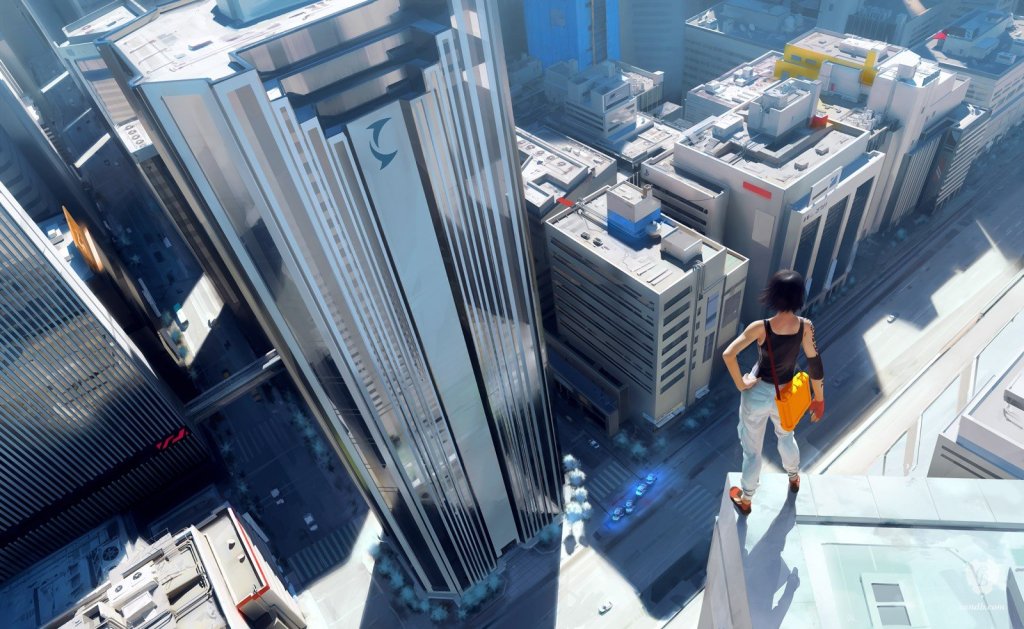Prince of Persia and Mirror’s Edge were released in the same year. While these two games couldn’t be more different on the surface, they have shared a common fate that helped evolve the games industry in way that where the influence can still be felt today. Prince of Persia and Mirror’s Edge helped define 2008, which was the year that movement was more fun than combat.
Mirror’s Edge was a game that was built around movement. It is a first-person parkour game that let players loose to explore and compete for time in a sprawling urban playground. The cityscape was designed to be run across, climbed on, and jumped over, with visual design to help players navigate the various routes without slowing down. With a strong, unique style, multiple routes to experiment with and a complex intricate system of movement and maintaining speed, the game was designed to be about traversal.
But the developers were worried, outside of racing games, movement was always a secondary concern to the more traditional notion of action. Combat had always been the focus of action games, whereas platformers — even those with some fighting mechanics — were seen as more childish, and more focused on exploration. To make sure the game was seen as more mature, DICE included some light combat. The studio tried to weave it into the fabric of the game, but it felt clunky and out of place. Despite this, Mirror’s Edge sold 2.5 million copies, thanks to its rewarding traversal and unique aesthetic.
The Prince of Persia from 2008 was a reboot for the franchise. The popular PS2 trilogy had come to an end, and Ubisoft wanted to reimagine the game and the format. With a beautiful cel-shaded design and color palette that evolved the more you played, the game looked fantastic. It had four gorgeous locations to explore all with their own incredible design, and players could use a variety of movement abilities to get around and soak up the locations.
The platforming sections were satisfying and challenging, with a steady sense of progress and reward. But once again, the combat fell flat. Controls were laggy and relied on the player memorizing combos like a fighting game but without any of the payoff. It got in the way of the flow of the game and Prince of Persia would have been better without it.
Racing Ahead

But these two games made the audience, and the industry, look at the traversal differently. It did not have to be secondary to combat for a game to be exciting and could its primary focus. Moving from space to space didn’t have to be simply running down a boring corridor or minimally jumping between platforms.
It could utilize interesting spaces with mechanics that challenge the player as they progress through the environment. Time could be spent developing a traversal system that was fun to play and wasn’t there just to pad out the game between encounters. If nothing else, the praise these games received for their traversal mechanics — and not their combat — showed that the latter did not have to be in every action game, and other mechanics could be the focus without the game failing. While neither title was overly commercially successful compared to the titanic GTAIV, which released the same year, the critical praise made the industry take notice.
And we have seen more and more action games since, both first and third person, focus more on traversal and platforming as a serious part of the player experience. One of the most obvious differences is between Uncharted: Drake’s Fortune and Uncharted 2: Among Thieves, which released on either side of 2008. The first Uncharted was the typical action shooter with just mild platforming between the fights, while the second had a much stronger platforming element as seen in the level with Tenzin and some of the other buddy segments. While not as revolutionary as Mirror’s Edge, the reframing of the action felt like the game better understood the fun that could be had outside of combat.
Can’t Stop, Won’t Stop

And this push to make movement interesting has persisted for a decade since 2008, even evolving to weave the action and the traversal together. Both Titanfall and Titanfall 2 focused heavily on movement, verticality, and integrating that with the shooter elements of the game.
This might never have existed without the experiments, successes, and failures of Mirror’s Edge and Prince of Persia first. Sunset Overdrive, a sadly overlooked early current generation game, had a strong emphasis on movement as well, encouraging the players to constantly be motion rather than taking cover or standing still, creating dynamic, shifting arenas to fight in. Even the incredibly popular Doom of 2016 was more than just a return to the ’90s shooter, as it had a much greater emphasis on movement and positioning in combat.
Traversal is now something that developers have to seriously consider, alongside the combat, gunplay or whatever action they want to include. Linear corridors are no longer good enough, and the shift away from them began in 2008 thanks to a runner and a man with a claw glove and long scarf.











